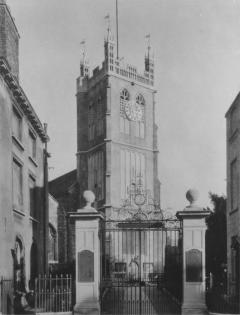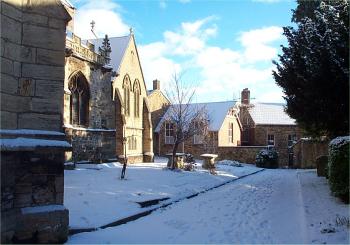

 |
 |
||||||||
| St. James Church, Dursley | ||||||||||
|
The origin of the Parish church of St. James Church in Dursley dates back to the 13th century although little evidence of the original building now remains. There is some evidence of a few remnants from this time in the present building but nothing is certain. Around 1320 much of the old building was demolished, although the tower was left standing, and a larger, grander building was constructed in its place. Once again there is little left from this period of history, the two arcades of octagonal columns being one example. |
||||||||||
 |
It seems that the church remained in this state for over 100 years until the mid 15th century when the small windows in the north aisle were replaced by the current ones (2003) and the carved roofs of the nave and north aisle were constructed. In 1480 further work was carried out when the old tower was replaced by a grander one built on the same foundations. This new tower had a clock and bells and was topped off by a spire. The south aisle was widened and a new higher root put up over the nave. Other construction work from this time included a new porch with a room above it, gargoyles and battlements. In 1645, during the commonwealth period, the alter was turned into a table in the nave, the font was sealed up and the bells were silenced. |
|||||||||
| St.
James Church, Dursley, c.1959 Courtesy Cam & Dursley Camera Club |
||||||||||
|
In 1698, a dramatic event occurred when the steeple collapsed, unfortunately killing some of the bellringers who were inside. The cost of replacement was estimated to be around £2000, out of reach of the Parish so a national appeal was started. An approach was made to King William III for his support:
|
||||||||||
|
John Awood Saml. King John Webb Jno. Arundell Junr. Saml. Clarke Joseph Dallimore Morris Phillips Thomas Fryer |
William
Litton Joseph Pulley Thomas Phelps Thomas Purnell Nicholas Neale James Harding Richard Tippetts John Purnell |
||||||||
|
It wasn't to be for several years however, in 1709 during the reign of Queen Anne, before the tower was rebuilt. Due to the high costs involved, the steeple was never replaced. Further changes continued throughout the 18th and 19th centuries. In the mid 18th century, the chancel was taken down and replaced. In 1824 a new peal of bells was installed and in 1832 all the pews were replaced and allocated to important parishioners. This caused somewhat of an upset as the town's poorer inhabitants had nowhere to sit and couldn't afford to buy their own pews. The consequence of this was the construction of St. Marks Church which was funded by Henry Vizard and consecrated in 1844 for the use of everyone. Later in the 19th century, a program of restoration was begun. The walls of the nave were taken down and new foundations laid before the walls were rebuilt using the original stones. The roof of the nave was raised 15ft. and windows installed underneath. In 1880 the large stained glass east window was put in and the three windows in the south aisle restored. |
||||||||||
| In 1920, a new floor was laid and the Baptistry redesigned. Names of the dead from the Great War were inscribed beneath the War Memorial window and then in 1945, following World War II, another memorial was erected in the Tanner Chapel in the south aisle. In 1967, further alterations were made when the High Alter was made freestanding, the chancel extended into the nave and the Lady Chapel redesigned. |  |
|||||||||
| St.
James Church, Dursley, December 28th 2000 Copyright Andrew Barton |
||||||||||
| In 2015, St. James Church continues to hold a prominent position in the town centre and plays an important part in the fortunes of the town. | ||||||||||